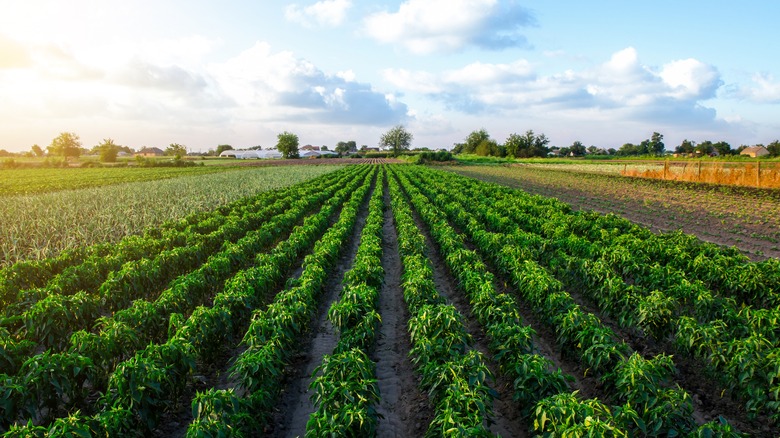How The USDA Is Attempting To Make Organic Farms The Norm
Imagine if every grocery store you walked into looked like Trader Joe's. Of course, we don't mean the Everything But the Bagel Seasoning or the vegan offerings. Instead, imagine if the products in every grocery store were mostly organic and totally GMO-free. According to a press release from earlier this week, the United States Department of Agriculture (USDA) is trying to make it happen.
Many consumers have questions about what the "organic" label really means, but it all comes down to how the food was grown. According to Healthline, organic food is defined as food that has been farmed without the use of hormones, antibiotics, GMOs, or chemicals, and is totally free of any artificial additives (including food coloring, sweeteners, flavor enhancers, and preservatives). Not only is organic food meticulously crafted, but they are also wildly popular. In 2020, Per the Organic Trade Association, U.S. consumers spent $61.9 billion on organic produce — a 12.4% increase from 2019. In fact, according to the USDA, there are currently over 28,000 certified organic farms across the U.S.
Organic foods have been growing in popularity for years. But now, it looks like organic food is having a moment. Here's how the USDA is attempting to make organic farms the norm.
Transitioning to organic is tough for farmers
In this week's USDA press release, the agency announced its New Organic Transition Initiative and its accompanying $300 million investment. The goal of the Initiative is to "help build new and better markets and streams of income for farmers and producers."
But, the task of becoming an organic farm is much easier said than done. According to Seasonally Fresh, to become "Certified Organic" by USDA standards, farmers must develop a detailed plan for transitioning their farm to an organic system. Then, the plan must be approved by a certifying agent, who will give the go-ahead for a thorough inspection of the farmer's facilities — which will then be reviewed by another certifying agent. Plus, according to the USDA press release, as part of the New Organic Transition Initiative, the agency will require farmers to totally eliminate the use of synthetic pesticides on their land for 36 months before becoming eligible for organic certification.
It's a lengthy process and not without risks for producers. "Farmers face challenging technical, cultural, and market shifts while transitioning to organic production, and even during the first years after successful organic certification," said Secretary of Agriculture Tom Vilsack via the USDA press release. So, how does the New Organic Transition Initiative plan to support new and aspiring organic farmers?
How the USDA plans to help
Per the USDA, the initiative will instate individualized financial guidance, establish channels of "farmer-to-farmer mentoring," promote farmer accessibility to organic consumer markets, and provide additional crop insurance. Considering the benefits of organic farming, the lasting effects will ultimately be worth the effort.
Healthline notes that organic farming also conserves groundwater and promotes soil quality. In addition, organic farming prevents pesticides from entering the environment: not only do these chemicals contaminate the air, soil, and groundwater, but often these pesticides cause crops to develop resistance to disease (via The Balance: Small Business). Pesticides, it says, have even been linked to the formation of algal blooms in water bodies near areas of farmland runoff.
However, organic farming offers a number of direct benefits to farmers, as well. According to the USDA, if farmers obtain "Organic Certification," they can charge premium prices for their products, support local economies, receive additional financial support from the government, and stake a more significant claim in regional markets. Plus, the "organic" label places farmers at an advantage in the economic game, too, the USDA explains that a more significant percentage of food sales go to organic producers than non-organic. Luckily, this new Initiative aims to make the transition to these advantages easier.


